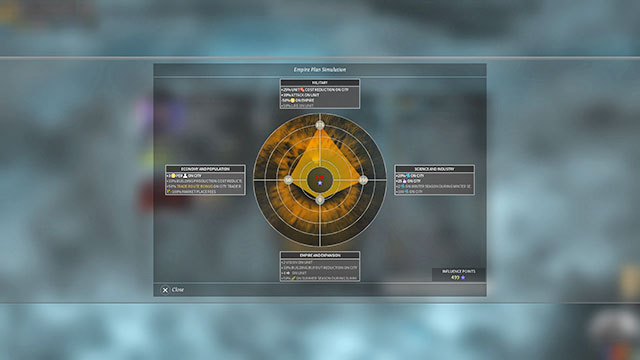Empire Plan | Empire management
Last update:

Every 20 turns, you will have the option to determine the plan for your empire. In general, this means selecting the bonuses that are going to be in effect, for your country, for the duration of the next 20 turns. The Empire plan has been divided into five parts, four per level and, just like diplomacy, it uses up Influence Points. Unlike diplomacy, it requires much more of them.
The successive levels of the empire plan become available with the successive eras, which means that you need to conduct research to gain access to them. Successive levels become available right after you advance to the next era. Therefore, if you are at the brink of a scientific breakthrough, and the moment at which you define a new empire plan, assign some of the subjects to research. 20 turns between the instances of defining an empire plan, may constitute a difference. Especially that the bonuses and discounts offered by it are quite high.
The plan requires Influence Points. Thanks to simulation, you are able to find out how many. Several turns before you set another plan, use this option. Thanks to this, you will know if you should temporarily increase the production of Influence Points in cities.
There is no one good Empire plan. It is necessary that you select bonuses depending on what you need and on the situation. For example, bonuses to scientific production, during winter, are not too useful, if summer was in full swing, for the successive 20 turns. Similarly with bonuses for units, if you are not waging any war, at the moment.
The cost of setting up the Empire plan, on the selected level, depends on the number of cities that you have and it looks in the following way.
The Era of improvement | Cost per city |
I | 20 |
II | 40 |
III | 90 |
IV | 250 |
For example, you want to set up a military plan for the 2nd level. You have 5 cities. For level 1, of the military plan, you spend, therefore, 100 Influence Points (5 x 20), and for the 2nd level 200 (5 x 40), which sums up to 300 Influence Points. You can experiment with expenditures in each field, as much as the cost does not exceed the amount of points that you actually have. While determining the plan, you will be able to monitor expenses on a regular basis.
Economy and population
The first era. Each citizen that produces Dust, now produces 3 units more. It is a bonus that is profitable for the factions that are concerned about increasing the size of treasure, such as Broken Lords or Roving Clans. As for the rest, the bonus is lower, because there are less people assigned to Dust production. If your main concern is the production of Dust, select this plan. Otherwise, buy it only if you are interested in additional bonuses.
The second era. The cost of building production - the amount of points necessary to build them - drops by 33%. It is an excellent bonus for the factions that produce, rather than buying, buildings. Very useful, especially at later stages of the game, where each building is costly. Buy it if you are up for buildings big numbers of structures and you want to speed it up a bit.
The third era. All of the trading routes in cities generate income higher by 50%. Very useful, especially if you own many cities that trade with each other. Thanks to this, not only will you be able to generate more Dust, but also more science and food. The latter is useful for each of the races, especially for Necrophages.
The fourth era. Eliminates market payments. These occur during selling and buying and they raise and lower the price. Therefore, it is a good idea to buy this level, if you trade often and you feel like saving up some Dust. If you produce lots of it, however, the price fluctuations are not that important to you.
Army
The first era . The reduction of unit production, by 25%. Just like in the case of buildings, it allows you to produce more units, at a lower cost in industry points. It is useful at the beginning, when you need to manufacture more units to defend against neutral bands. Also later on, its value does not drop, because it helps you manufacture units equipped with expensive gear of higher levels.
The second era. Each unit receives a bonus of 30% to attack. Unnecessary in peace time, especially if you have already pacified all of the neighboring villages. In wartime, it is an important bonus, especially for strong units and heroes.
The third era. Decreases cost of buildings and units, all around the empire, by 50%. A bonus necessary for all of the empire. It is especially going to be beneficial for the Dust -oriented factions and also for the players with too large armies and to the players balancing, at the verge of budgetary deficit.
The fourth era. Each unit receives a bonus of 50% to health points. Just like in the case of the bonus for the second era, it is useless in peace time, in wartime it becomes a must-have.
Science and industry
The first era . Cities generate 20% science points more. At the initial stage of the game, take it on the spot. Thanks to this, you will save several turns on inventions and you will reach the second era faster. Later into the game, also take it, because the cost of research gets higher and because of that, each bonus is worth its weight in gold. Scientific research is one of the fields that separates strong countries from the weak ones so, if you can speed up research, do that.
The second era. Each city receives 25 additional points to support. Later into the game, it may save you, due to the large number of cities and citizens in them, It may seem a scanty amount but, later into the game, 25 points may draw the line between penalties to production and no penalties.
The third era. A +2 bonus to the production of science points in winter. It is unclear, whether it is a bonus per city or per a field of the map. Still, it is additional 2 points which will always be of use. If, during the next 20 turns, there is going to be winter, invest in this level. Otherwise, you can ignore it.
The fourth era. Cities generate 100 science points more. A very useful bonus, however expensive and available later into the game, when many of the technologies have already been developed. It is useful, if you want to progress to the next turn faster, or gain an easy access to the earlier technologies that have not yet been developed.
Empire and expansion
The first era. Each unit receives +2 to the range of vision. It is good during wartime and during reconnaissance, especially if you have dispatched many groups. Otherwise, and also if you are not interested in additional bonuses, you can ignore this one also.
The second era. decreases the cost of the buildings that you buy, by 33%. If you generate lots of Dust and you prefer to buy buildings, instead of producing them, this bonus is a good choice. You can experience the difference especially in the case of buildings of the third and the fourth eras.
The third era. Each unit receives +4 movement points. This bonus is especially useful for the factions such as the Roving Clans, which can cover large distances fast, thanks to it. It will also be useful to the other factions, especially if they do not yet have a vast net of roads, have to move over sea or find it difficult to catch up with the fleeing enemy army. As a matter of fact, it is easy to find a reason, for which this one is worth investing in.
The fourth era. Increases food production by 50% in summer time. A problematic level. It becomes available quite late into the game, when the majority of cities are large and it us unclear what the increased food production rate relates to. Apart from that, its significance drops as you progress in the game, when winters become more frequent and longer. Invest in this level only in the case of urgency.
You are not permitted to copy any image, text or info from this page. This site is not associated with and/or endorsed by the Iceberg Interactive or Amplitude Studios. All logos and images are copyrighted by their respective owners.
Copyright © 2000 - 2025 Webedia Polska SA for gamepressure.com, unofficial game guides, walkthroughs, secrets, game tips, maps & strategies for top games.
